GOURMET FERTILIZER
Vegetarian Plants
The other day in the hardware store I overheard someone ask the clerk for some rose food. My eyebrows went up as I thought to m’self, “Are they kidding, thinking that roses need their own special food? Next, I’ll hear about plants that prefer vegetarian or kosher food, perhaps fish emulsion on Fridays?”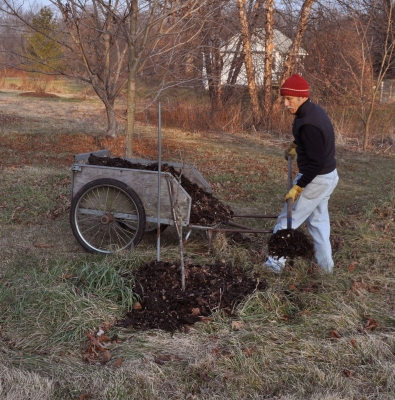
All this food science when it comes to plants may boost fertilizer sales, but it hardly bothers plants either way. Plants take up the bulk of their nutrients as ions (charged atoms or groups of atoms) that are dissolved in water in the soil. Rock particles, as well as humus and organic fertilizers, decompose to release nutrient ions slowly into the soil solution. Chemical fertilizers are already in ionic form, so when you sprinkle a handful on the soil, they dissolve as soon as they contact water.
A Well-Rounded, Wholesome Diet
What’s so special about rose food for roses? Nothing. All plants need healthy doses of nitrogen, phosphorus, and potassium, and lesser amounts of other nutrient elements. But unless a soil is an infertile sand where neither crop rotation nor some weed growth is allowed to balance soil nutrients, specific foods don’t usually have to be tailored for specific plants.
My garden grows pretty well, and I feed all my plants the same diet: An annually replenished mulch of wood chips, leaves, or compost, and, if extra nitrogen is needed, an annual sprinkling of soybean meal. Theoretically and in practice, an inch depth of compost alone provides sufficient nourishment for the plants. 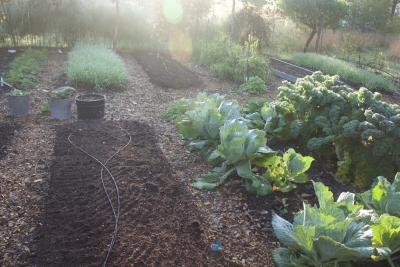 That inch depth of compost is the only thing my vegetable beds get each year, and it nourishes closely planted cabbages, tomatoes, lettuces, and other plants from the first breath of spring until cold weather barrels in to shut down production.
That inch depth of compost is the only thing my vegetable beds get each year, and it nourishes closely planted cabbages, tomatoes, lettuces, and other plants from the first breath of spring until cold weather barrels in to shut down production.
Garden plants that are pressed into sustained production (nonstop flowering of those rose bushes, for example) or vegetables best plumped up with extra-succulence, like some leafy vegetables, might need an extra push with additional nitrogen. Or not.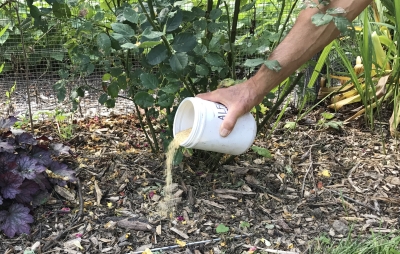
Soybean meal, available in garden centers as well as anywhere selling animal feeds, is insurance in the form of a high nitrogen, organic fertilizer. Cottonseed meal, hoof and horn meal, alfalfa meal, or blood meal would serve as well. Soil microorganisms decompose the proteins in any of these fertilizers in a series of steps to produce amino acids, then ammonium ions, then nitrate ions. The latter two ions are the forms of nitrogen most utilized by plants.
I grew Brussels sprouts unsuccessfully for many years, with sprouts hardly bigger than marbles lining up along the spindly stalks. So last year, I sprinkled some soybean meal (2 pounds per hundred square feet) on the ground before laying down the compost. Success! The plants grew into sturdy, five-foot-high stalks along which were lined up almost golfball-sized sprouts.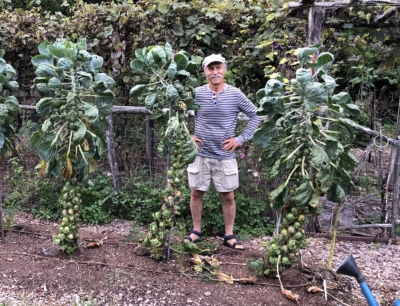
Flowers and mature trees and bushes get nothing more than arborists’ wood chips, leaves, hay, straw, or wood shavings here. Even these low nitrogen mulches eventually release nitrogen as their lower layers break down in the soil.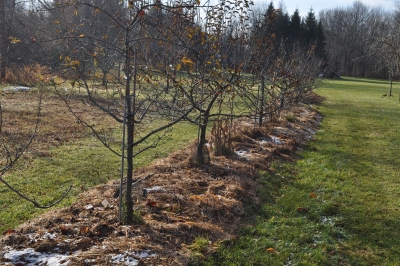
But Still . . .
You might point out that, still, there are some plants that need a specialty plant food: “acid plant food” for azaleas and rhododendrons, for example. You’ve got a point; these plants do have special needs. But my universal pabulum of mulch and soybean meal also suffices for them.
The special requirement of these plants is an acid soil. If a soil is not naturally acidic, the soil doesn’t need an “acid plant food,” it needs to be made acidic. The way to make a soil acidic is with sulfur, a naturally mined mineral. The amount needed depends on the existing soil acidity (determined with a quick soil test), the desired soil acidity (a pH of about 5 for acid-loving plants), and whether the soil is sandy or clayey. A sandy soil needs about 3⁄4# per 100 sq. ft. for each pH unit change; clay soils need about two-and-a-half times that amount. The sulfur to use is “pelletized” because it’s less dusty to work with. And, obviously, any compost for these plants should have had no added limestone.
What about the special nitrogen requirement of these plants? Commercial “acid plant food” supplies acid-loving plants with their preferred form of nitrogen, which is ammonium ion. Let’s see what happens to my soybean meal in an acid soil. A few paragraphs earlier, I wrote that though an orchestrated series of steps, various soil microorganisms gobble up proteins in soybean meal or other organic fertilizers, breaking them down to amino acids, ammonium ions, and then nitrate ions. In acidic soils, microorganisms that do that last job are absent. Breakdown stops at ammonium ion — just what those plants like best.
Plants don’t need haut cuisine, just plain, wholesome food. (More details about this in Weedless Gardening and The Ever Curious Gardener.)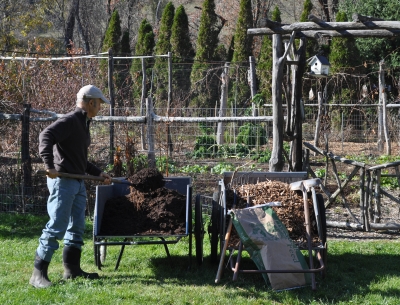


Great post! I’ve often wondered if all of these “special” plant foods are really necessary or if they’re more of a marketing thing. Now I know!
P.S. Those are some impressive Brussels sprouts!
Lee:
What is your opinion about “Milorganite”?
I haven’t checked it out for a long time. Originally there was concern from heavy metals. Not sure now. It’s supposed to be very effective at keeping deer at bay.
Hi Lee:
Nice subject to follow up on pertaining to soybean meal. Great if you can find it. I am still searching. I questioned over a half dozen places today and they all looked at me like what is he talking about.
I still have to visit a garden center. Another place wanted to sell me 50 pounds
for $30.00. I will find it.
Thanks for your info. Ken F.
Yes, when it’s sold as feed it comes in large quantities. Cottonseed meal might be easier to find at a garden center or hardware stoe, and it’s about equivalent to soybean meal.
Des allé,
Thank for making complex horticulture so clear and concise!
Some cut my five foot tall healthy 5 -year old limelight hydrangea to the ground last week. The landscaper also cut my enormous healthy oak leaf hydrangea to the ground. This is on Martha’s Vineyard. Do you think these plants will come back to their height and flower in this season?? thank you!
Olivia
Oak leaf hydrangea definitely won’t flower this year, possibly not the limelight. But both plants will grow very vigorously this coming season.
Great sharing of info, Lee. Much appreciated! I will get me a bag of soybean meal for my brussels sprouts. Any feedstore, huh? Doesn’t have to be organic? No dicamba or other weed killer residue?
It’d be nice if it was organic, but not readily available. I would use it just to support organics. I don’t think much ill effect, if any, from nonorganic soybean meal.
Thank you, Lee! When I worked in a nursery I used to explain this to customers by using the human analogy of “one person is Italian, another is Chinese, does that mean they cannot eat each other’s cuisine and be healthy?”.
Good one. I like that.
I get huge bags of Plant-tone, Garden-tone & Holly-tone. All are organic and all work great. And they don’t cost much either. Plant-tone has extra nitrogen which the kale & corn love. The peppers, tomatoes & watermelon appreciate the Garden-tone. And the blueberries get better every year with the help of the extra sulfur in the Holly-tone. All of my compost & worm castings get used in my conventional garden beds, but more inputs are still needed. Many urban gardens like me don’t have room for massive onsite compost piles. I have to make every inch count. I have a worm bin & a large tumbler. But without the extra nutes my plants would not produce at the high density that they do.
I found this post very, very informative. Had the same experience as you for years with Brussels sprouts, which we love. Decided to stop trying to grow them so your post is inspiring. We live in lower Westchester (NY), so no feed stores. The commercial high N garden fertilizers here are $$$. We checked out soybean meal and cottonseed meal online and didn’t find anything with those specifications except for items that were feeds for certain animals. Could not tell if these feeds had other ingredients like antibiotics, etc. So could you provide some brand names and possible places to purchase? Also open to the other sources you recommended, such as hoof and horn meal, alfalfa meal, blood meal, but want to make sure they are safe and organic for our veggies (and affordable). Thanks so much for all the info you are providing.
Plain soybean meal, with no additives, is available and sold as animal feed. That’s what I use.